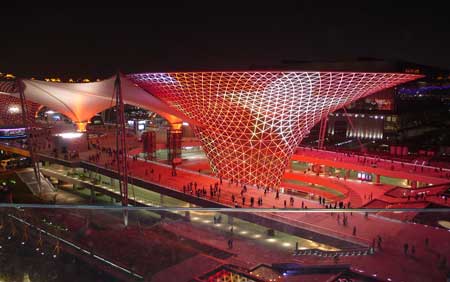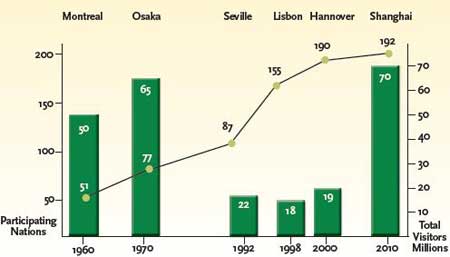|
|


ADVERTISEMENT
Buy Your own advertising
spaces!
.
Download Adobe Acrobat Reader to open [PDF] files.
Recent Visitors
Expo 2010 Shanghai: Is it worth it?
2010. 7 June
 The Expo Axis, a 2010 Shanghai Expo landmark, as seen at night. (photo: CFP)
The Expo Axis, a 2010 Shanghai Expo landmark, as seen at night. (photo: CFP)
by Waldemar Pfoertsch
(business.globaltimes.cn)
For the last 150 years, world fairs and world expos have been held all over the globe. Now, it is Shanghai's turn to shine. Thanks to the foresight of the International Exhibitions Bureau and the Shanghai municipal government, Expo 2010 has been timed to take place at the beginning of a new era: China's integration into the world.
Large investments from China and abroad have made this event a showcase, where local and foreign visitors find themselves in the midst of dynamic world changes, witnesses to China's latest achievements and its role as an important contributor to this global transformation. Of the anticipated 70 million visitors, 97 percent are expected to come from China, which clearly makes this an event for the Chinese people. But through the international media, the whole world has a ringside seat to what is happening in Shanghai from May 1- October 31.
Over the years, successive World Expos have been valuable branding tools for various countries, enterprises and other participants. The first World Expo was held in The Crystal Palace in Hyde Park, London in 1851 under the title of "Great Exhibition of the Works of Industry of All Nations". It was the brainchild of Prince Albert, Queen Victoria's husband. The event presented British-manufactured goods to the world, showcasing Great Britain's industrial, military and economic superiority. It also initiated the rapid spread of industrialization and influenced the development of art and design, education, international trade and relations, and even tourism.
In the US, Philadelphia was the first city to host a World Expo, in 1876. It was a chance for Americans to establish their industrial and cultural presence in the global arena. In 1889, the Eiffel Tower was opened in Paris and France demonstrated its newest technological and scientific achievements.
The expos that followed continued to foster more cultural exchange and the spread of industrialization. Among the highlights over the years: Japan made its debut on the world stage with the 1970 Osaka World Fair. Like the 1964 Summer Olympics in Tokyo, Expo 70 was a success with more than 65 million visitors. It served as a symbol of Japan's extremely rapid development in the 1960s. Expo 2000 in Hannover helped to solidify reunited Germany. It could have been a great opportunity for country branding but, unfortunately, only 19 million of the expected 40 million visitors materialized. During the 1984 New Orleans Fair, a mere 7 million visitors turned up and the event (which was competing with the 1984 Summer Olympics in Los Angeles and also plagued by a lack of major exhibits) went bankrupt. The show eventually went on with government help, but since then the US has shied away from staging the World Expo.
Now Shanghai wants to outdo all previous Expos with numbers that boggle the mind. Participation by 192 countries plus 50 international organizations, 20,000 multicultural shows, and hundreds of tons of food are all available for the pleasure of the 70 million visitors expected. This is the first time a World Expo is being held in a developing country, and the size of the event is unprecedented. The ground area covers 5.3 square kilometers with nine entrance/exit gates; and thousands of new "Expo taxis" were put on the road to provide easy access. The Shanghai municipal government has invested heavily in the city's infrastructure and appearance, and in making security a top priority.
 Development of participating nations and number of visitors at world expos from 1960-2010 Source: CEIBS research.
Development of participating nations and number of visitors at world expos from 1960-2010 Source: CEIBS research.
For the Chinese government, this expo is not only a great opportunity to demonstrate the accomplishments of the new China, it is also an effective way to brand China - by clearly outlining the country's rapid transformation goals to its people and to the foreign media. The message is clear: China's position in the global world is being demonstrated in a peaceful way, promoting trust between the country and the outside world.
In addition to China's largest-ever investment in the history of the World Expo, other participating countries and organizations have also invested heavily in their pavilions and activities. Only a few countries have made their numbers public - US: $60 million, Germany: EUR30 million ($ 35.89 million), and the Czech Republic: EUR23 million ($ 27.52 million). Even with this limited data, it is clear that even if 70 million visitors do show up, these huge sums cannot be recovered during the seven-month event. But participating countries and institutions may take comfort in the fact that this is an investment in a joint future, an investment for a better world.
While the 2008 Beijing Summer Olympic Games showcased global athletic achievements, the Shanghai Expo is a stage for the world's scientific and industrial triumphs, providing an "invisible pavilion" for cultural exchange and worldwide recognition. It comes as no surprise that many institutions and companies want to capitalize on this ex-cellent branding opportunity. In almost every country pavilion, the investment made by the business sector is evident: from providing exhibits to offering transportation, their presence cannot be overlooked. In fact, the event's major corporate sponsors - such as State Grid, Coca Cola, BaoSteel, SAIC/GM, and Siemens - have their own pavilions. Just as with Expo 2000, direct sponsorship, events, and company advertisements have actually made the Shanghai Expo more attractive to visitors.
There is no doubt that China has become one of the main engines in today's global economy, and hosting Expo 2010 seems to be the manifestation of the country's achievements and its importance in the international arena. The expo combines a display of industrialization and technological triumphs with the promotion of cultural exchange and country branding at the highest level.
To put this grand event into context, the 2010 Expo is as important to the Chinese as the "Great Exhibition" was to Victorian Britain. Not only will it boost national pride, but if the dialogue between China and the world continues in this positive fashion, there is a great chance that the investments - of all parties involved - will be worth it.
Waldemar Pfoertsch is Associate Professor of Marketing at CEIBS, Shanghai and Professor of International Business at Pforzheim University, Germany.
Source:business.globaltimes.cn

